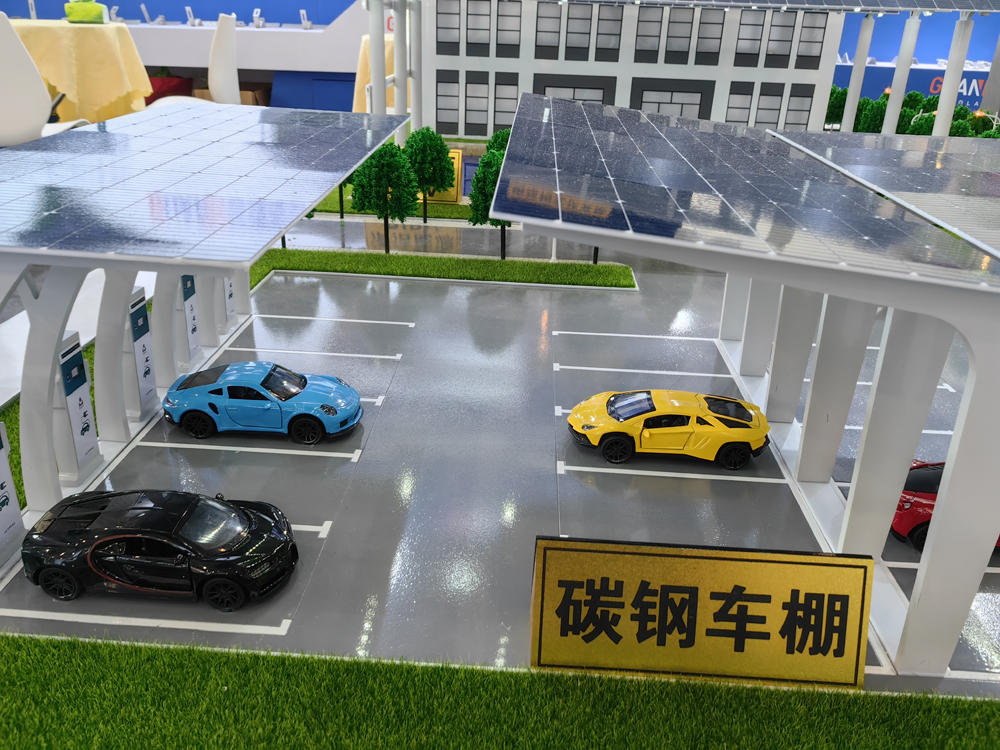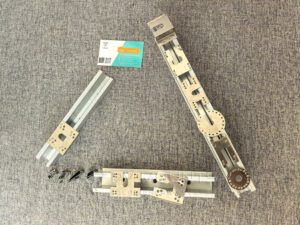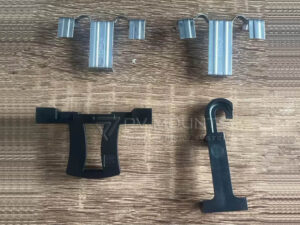ما هو مرآب السيارات الشمسي؟ مرآب السيارات بالطاقة الشمسية تمثل مزيجاً مبتكراً من تكنولوجيا الطاقة المتجددة والمرافق اليومية. صُممت هذه الهياكل في جوهرها لتوفير مأوى للمركبات مع تسخير الطاقة الشمسية من خلال الألواح الكهروضوئية المثبتة على سقف المرآب. لا تعمل هذه الوظيفة المزدوجة على تحسين أماكن وقوف السيارات فحسب، بل تساهم أيضاً في توليد الكهرباء بشكل مستدام، بما يتماشى مع الجهود العالمية للتخفيف من آثار تغير المناخ.
يكشف تتبّع مسار مرائب السيارات الشمسية عن رحلة من التطور التكنولوجي والاعتماد المتزايد عليها. فبعد أن كان يُنظر إليها في البداية على أنها منشآت متخصصة للأفراد أو المؤسسات المهتمة بالبيئة، تجاوزت هذه المركبات مكانتها المبكرة. في الوقت الحاضر، يتم الاحتفاء بمرائب السيارات الشمسية لفوائدها المتعددة الأوجه، بدءاً من أثرها البسيط على البيئة إلى الوفورات الاقتصادية التي تقدمها. وقد غذت هذا التحول التطورات في التكنولوجيا الكهروضوئية هذا التحول، مما جعل من مرائب السيارات الشمسية عرضاً مقنعاً لكل من العقارات السكنية والتجارية.
جدول المحتويات
تصميم وهيكل مرآب السيارات الشمسية
المكونات والمواد
يتميز التصميم المعماري لمرآب السيارات الشمسية ببساطته وكفاءته. وتشمل المكونات الأساسية الإطار الفولاذي الذي يوفر دعماً قوياً والألواح الكهروضوئية التي تمثل قلب قدرة المرآب على توليد الطاقة. يتم اختيار المواد بناءً على متانتها، مع تفضيل المواد التي يمكنها تحمل قسوة الطقس والوقت، مما يضمن طول عمر التركيب.
أنواع تصاميم مرآب السيارات الشمسية
يسمح التنوع في التصميم لمرائب السيارات الشمسية بالاندماج بسلاسة في مختلف الإعدادات. من التكوينات المكونة من صف واحد المثالية للاستخدام المنزلي إلى الإعدادات الواسعة متعددة الصفوف للمساحات التجارية، تتضح قدرة تصميمات مرآب السيارات الشمسية على التكيف. كما أن الابتكارات في العناصر الجمالية تعني أيضاً أن هذه الهياكل يمكن أن تكمل السمات المعمارية لمحيطها، مما يجعلها حلاً متعدد الاستخدامات لوقوف السيارات وتوليد الطاقة.
كيف تعمل مرآب السيارات الشمسية
العملية الكهروضوئية
تكمن في قلب مرآب السيارات الشمسي العملية الكهروضوئية، وهي أعجوبة هندسية تحوّل ضوء الشمس إلى كهرباء. يحدث هذا التحويل عندما تصطدم الفوتونات المنبعثة من ضوء الشمس بالخلايا الكهروضوئية، مما يؤدي إلى توليد تيار كهربائي. وتُعد كفاءة هذه العملية دليلاً على التقدم في تكنولوجيا الطاقة الشمسية، مما يجعل مرآب السيارات الشمسية مصدراً موثوقاً للطاقة الخضراء.
التكامل مع الشبكة
وغالباً ما تتميز مرائب السيارات الشمسية بالتكامل مع الشبكة الكهربائية، مما يسمح بإعادة تغذية النظام بالطاقة الزائدة عن الحاجة مما يساهم في إمداد المجتمع بالطاقة. هذه العلاقة التكافلية لا تؤكد فقط على فائدة مرائب السيارات الشمسية في تحقيق الاستقرار في الطلب على الشبكة، بل توفر أيضاً إمكانية تحقيق عوائد مالية للمساهمة في الطاقة، مما يعزز جاذبيتها.
فوائد الطاقة الشمسية للمركبات الكهربائية
الأثر البيئي
إن المزايا البيئية لمرآب السيارات الشمسية عميقة. فمن خلال توليد طاقة نظيفة ومتجددة، فإنها تقلل إلى حد كبير من الاعتماد على الوقود الأحفوري، وبالتالي تقلل من انبعاثات غازات الاحتباس الحراري. تؤكد هذه المساهمة المباشرة في مكافحة تغير المناخ على الدور المحوري الذي يمكن أن تلعبه مرائب السيارات الشمسية في تعزيز مستقبل مستدام.
المزايا الاقتصادية
بالإضافة إلى فوائدها البيئية، توفر مزايا اقتصادية ملموسة. ويشكل الانخفاض في فواتير الكهرباء، إلى جانب الأرباح المحتملة من الطاقة التي يتم تغذيتها مرة أخرى إلى الشبكة، حجة مالية مقنعة. وبالإضافة إلى ذلك، فإن الزيادة في قيمة العقارات وتوافر الحوافز الحكومية تزيد من المبررات الاقتصادية لاعتمادها.
عملية تركيب مرآب السيارات الشمسية
تقييم الموقع
يسبق تركيب مرآب الطاقة الشمسية تقييم دقيق للموقع. يضمن هذا التقييم أن يكون الموقع المختار ملائمًا لزيادة التقاط الطاقة الشمسية إلى أقصى حد مع مراعاة عوامل مثل توافر المساحة والتوجيه. والهدف من ذلك هو التأكد من الجدوى وتحسين التصميم ليتناسب مع الخصائص المحددة للموقع.
التصاريح واللوائح التنظيمية
يعد التنقل بين التصاريح والمشهد التنظيمي خطوة حاسمة في عملية تركيب مرآب السيارات الشمسية. فالامتثال لقوانين البناء المحلية وقوانين تقسيم المناطق واللوائح الكهربائية أمر ضروري لضمان سير المشروع بسلاسة. وغالباً ما تنطوي هذه المرحلة على تعاون وثيق مع السلطات البلدية والهيئات التنظيمية، مما يؤكد أهمية التخطيط والتنسيق الشاملين.
تحليل تكلفة مراحيض الطاقة الشمسية
الاستثمار المبدئي
على الرغم من أهمية التكلفة الأولية لمرآب السيارات الشمسية إلا أنه يجب تقييمها في سياق الفوائد طويلة الأجل التي تقدمها. يشمل هذا الاستثمار الأولي تكلفة المواد والعمالة وأي رسوم تصاريح مرتبطة بها. ومع ذلك، فإن انخفاض تكلفة تكنولوجيا الطاقة الشمسية وتوافر خيارات التمويل يجعل الوصول إلى مرائب السيارات الشمسية متاحاً بشكل متزايد.
العائد على الاستثمار والمدخرات
يتم التأكيد على الجدوى المالية لمرآب السيارات الشمسية من خلال العائد على الاستثمار (ROI) الذي تقدمه. ويتجلى هذا العائد على الاستثمار من خلال انخفاض فواتير المرافق، وفي بعض الحالات، الأرباح من الطاقة التي تساهم بها في الشبكة. وعلاوة على ذلك، فإن طول عمر مرائب السيارات الشمسية يضمن تراكم هذه المدخرات بمرور الوقت، مما يؤدي في كثير من الأحيان إلى أن يدفع النظام ثمنه ثم بعضه.
التحديات والاعتبارات
التحديات الخاصة بالموقع
يمكن أن يواجه تنفيذ مرائب السيارات الشمسية تحديات خاصة بالموقع، مثل القيود المكانية أو التعرض غير المواتي للشمس. وتتطلب معالجة هذه المشكلات حلولاً تصميمية مبتكرة وربما دمج التكنولوجيا لتعزيز التقاط الطاقة، مما يضمن جدوى المشروع بغض النظر عن القيود الأولية للموقع.
متطلبات الصيانة
على الرغم من أن مرآب السيارات الشمسية منخفض الصيانة نسبياً، إلا أن الفحوصات الدورية والتنظيف ضروريان للحفاظ على الأداء الأمثل. إن التأكد من خلو الألواح الكهروضوئية من الحطام أو الظل أمر بالغ الأهمية، حيث يمكن أن تؤثر هذه العوامل بشكل كبير على كفاءة توليد الطاقة. لا تؤدي الصيانة الدورية إلى إطالة عمر المنشأة فحسب، بل تحافظ أيضاً على قدرتها على إنتاج الطاقة.
المقارنة بين مرابط السيارات الشمسية ومرابط السيارات التقليدية
الاختلافات الجمالية والوظيفية
تتميز مرائب السيارات التي تعمل بالطاقة الشمسية عن نظيراتها التقليدية من خلال التحسينات الجمالية والوظيفية. تعمل التصاميم الأنيقة والتكامل التكنولوجي على الارتقاء بالجاذبية البصرية لمواقف السيارات مع توفير وظائف إضافية لتوليد الطاقة النظيفة. هذا النهج المزدوج الغرض لا يزيد من فائدة المساحة فحسب، بل يساهم أيضاً في توفير بيئة مبنية أكثر استدامة.
المزايا طويلة الأجل
تمتد الفوائد طويلة الأجل لمرابط السيارات العاملة بالطاقة الشمسية إلى ما هو أبعد من الوفورات المالية الفورية لتشمل الحفاظ على البيئة والاستقلالية في مجال الطاقة. فمن خلال تيسير التحول نحو الطاقة المتجددة، تلعب مرآب السيارات العاملة بالطاقة الشمسية دوراً حاسماً في الحد من آثار الكربون وتعزيز الاستدامة، وهي مزايا لا يمكن أن توفرها مرآب السيارات التقليدية.
دراسات حالة: قصص نجاحات الممرات الشمسية للمركبات الشمسية
أمثلة سكنية
تجسد مرآب السيارات الشمسية السكنية التطبيق العملي لهذه التكنولوجيا في بيئة منزلية. وتكشف دراسات الحالة عن كيفية تسخير أصحاب المنازل لمرابط السيارات الشمسية لتخفيض تكاليف الكهرباء بشكل كبير مع المساهمة في الاستدامة البيئية. وتُعد قصص النجاح هذه بمثابة شهادات قوية على جدوى وفوائد مرائب السيارات الشمسية في السياقات السكنية.
التطبيقات التجارية والبلدية
يُظهر اعتماد مرائب السيارات الشمسية في الأماكن التجارية والبلدية قابليتها للتوسع وتعدد استخداماتها. فمن مواقف السيارات الخاصة بالشركات إلى الحدائق العامة، تُظهر هذه التركيبات إمكانية استخدام مرائب السيارات الشمسية لتوفير حلول الطاقة المستدامة على نطاق أوسع. ويُعد التأثير الإيجابي على مبادرات الطاقة المجتمعية وإظهار الريادة البيئية من بين أبرز السمات الرئيسية لهذه التطبيقات.
مستقبل مرافئ الطاقة الشمسية
الابتكارات التكنولوجية
يرتبط مسار مواقف السيارات العاملة بالطاقة الشمسية ارتباطاً وثيقاً بالابتكارات التكنولوجية في مجال الخلايا الكهروضوئية وتخزين الطاقة. وتبشر التطورات في هذه المجالات بتعزيز كفاءة وقدرات التخزين في مرائب السيارات الشمسية، مما قد يُحدث ثورة في الطريقة التي نفكر بها في مواقف السيارات واستخدامها لتوليد الطاقة.
توسيع نطاق إمكانية الوصول والاعتماد
كما يتوقف مستقبل مرائب السيارات الشمسية على الجهود المبذولة لتوسيع نطاق إمكانية الوصول إليها واعتمادها. إن المبادرات التي تهدف إلى خفض التكاليف، إلى جانب السياسات التي تشجع على دمج حلول الطاقة المتجددة، هي مبادرات محورية في إدخال مرائب السيارات الشمسية في التيار الرئيسي. وبينما تؤتي هذه الجهود ثمارها، تستعد مرائب السيارات الشمسية لتصبح عنصرًا أساسيًا في مشهد البنية التحتية المستدامة، مما ينير الطريق نحو مستقبل أكثر اخضرارًا وكفاءة في استخدام الطاقة.













